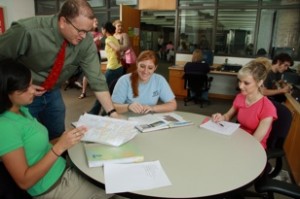C-I Course Design Examples
 Below are selected C-I course development worksheets that demonstrate successful application
of C-I methodologies. Effective C-I assignments not only help students improve their
communication skills but also foster a greater understanding of the course content
and hone critical thinking skills.
Below are selected C-I course development worksheets that demonstrate successful application
of C-I methodologies. Effective C-I assignments not only help students improve their
communication skills but also foster a greater understanding of the course content
and hone critical thinking skills.
Faculty are encouraged to use these samples to improve their own course design. CxC is
committed to exploring new ways of thinking about teaching at LSU. Check back often,
as new ideas are continuously being added to this page.
- A biology professor requires that students research and write Wikipedia entries to
increase public access to information on microbial diversity. He also uses twitter
in the classroom to encourage active learning in productive and accountable ways.
- An art professor models the start-to-finish process of multimedia digital content
creation, focusing on the necessary interplay between different writing genres, spoken
communication, technology as a communication tool, and the practical considerations
for project management as an iterative process.
- An architecture professor teaching students about vernacular and material culture
emphasizes the importance of translating disciplinary content into language and visuals
that an outsider can understand.
- A religious studies professor teaching about religion in the United States requires
his students to research and write blog posts and book reviews for public-facing websites,
and to research, create and edit oral histories for submission to the Library of Congress
and local oral history centers.
- A biology professor certifies his 1-credit lab course as writing intensive, incorporating
intentional study of scientific writing to the practice of scientific research and
writing.
- A chemical engineering professor focused on creative and collaborative problem solving
requires his students to practice spoken and written communication in team settings
using varied forms of collaborative technology.
- A mechanical engineering professor requires engineering students to translate their
mathematical and technical skills into written and oral formats in preparation to
defend their design work for a panel of professional engineers and industry partners.
- An English professor requires her students to engage poetry via technology, analyzing
others’ uses of technology in video poems and, by the close of the semester, students
themselves are using digital tools to create and execute video poems. Like other professors,
she uses twitter as a tool in the classroom to explore the interplay between poetry
and collaborative creation.
-